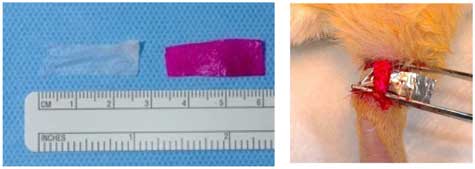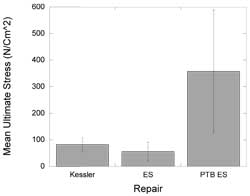
Tendon is an ideal tissue for photochemical bonding because it is composed almost entirely of collagen. However, tendon is also opaque leading to difficulty in achieving full cross-sectional light-activated tendon-tendon bonds. Our solution is to minimize the suture burden in the surgical repair of a load-bearing tendon like Achilles tendon and then augment this repair by bonding a modified, electronspun silk nanofiber graft over the repair site to provide tensile strength (Datta et al., unpublished results). In a rat Achilles tendon model the tendons repaired in this manner demonstrated much greater tensile strength following repair leading to the possibility of an earlier return to mobilization and load-bearing, which are important determinants in functional outcome. An earlier return to full activity would be a great benefit to the patient and in the socio-economic impact of a reduced rehabilitation time and earlier return to the work force.
 |
| Figure 9. Left panel -Transparent electrospun silk mat with and without impregnation with the photoactive dye, Rose Bengal. Right panel – rat Achilles tendon rupture repaired by light-activated bonding of silk nanofiber sheath. |
 |
| Figure 10. Increase in tensile stress of rat Achilles tendon repair at 14 days post-op. Both standard Kessler suture repair and repair augmented by an electrsopun silk (ES) graft sutured in place produced significantly lower tensile strength than the group where the modified electrospun silk graft was photochemically bonded in place (PTB ES) over the repair site. |
Research Projects
Mechanisms for light activated protein crosslinking
Closure of surgical wounds
Cornea: sealing incisions and transplantation
Peripheral nerve repair
Tendon repair
Blood vessel repair
Neocartilage generation













